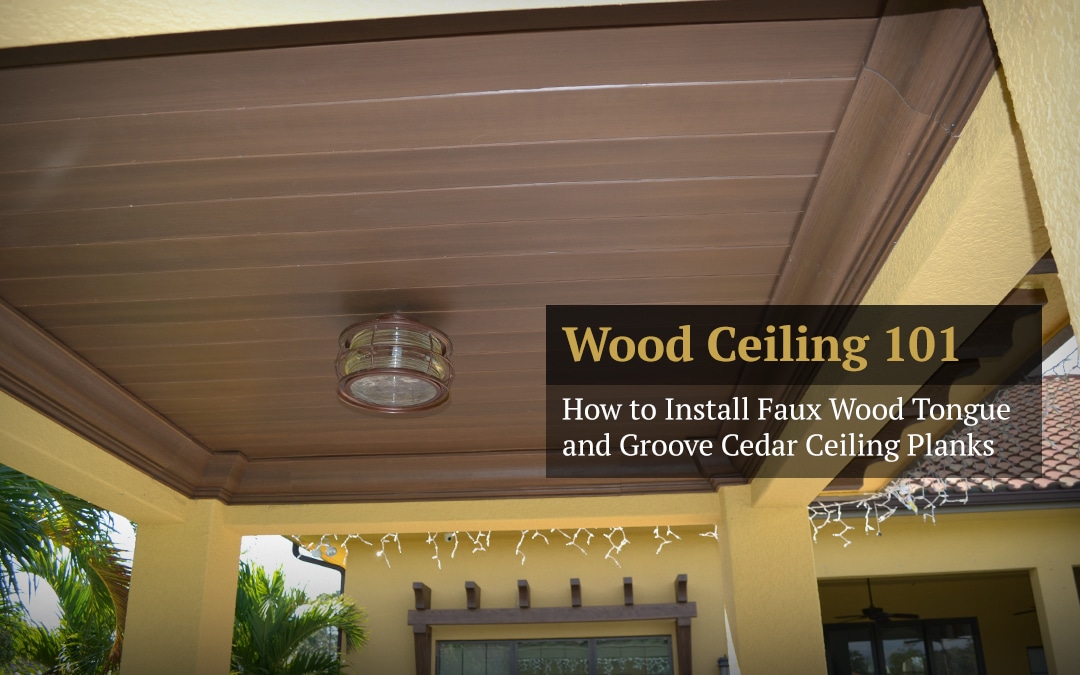Tags: Faux Wood, Faux Wood Beams, Faux Wood Beams for Ceiling, Faux Wood Ceiling Beams, Faux Wood Planks
Do you ever look up at your ugly popcorn ceilings and wish you could transform them into something modern and beautiful? Do you want to bring some natural beauty into your home? If so, faux wood cedar ceiling planks can be an amazing addition to your home.
Installing tongue and groove ceilings is a great way to upgrade your home in a weekend. Read on to learn more about how to install tongue and groove ceiling planks.
Prep the Board Ends
When you get your faux wood tongue and groove boards, each end of them will have staples and tags attached to it. The ends may not be square, and they might be uneven. Before you install your boards, you need to prep the ends to make sure they’ll fit together smoothly once you get them on the ceiling.
Use a square to cut an even end on your boards, making sure to clip off any splinters that stick up. You may also want to consider adding a 45-degree bevel called a chamfer to your boards. This will help to mask any small inconsistencies in your joints and give your ceiling a more finished look.
Finish the Boards
It may seem counterintuitive, but the next thing you need to do before you install faux wood tongue and groove wood ceiling panels is to finish the boards. You’re not going to want to do all that staining and sanding once the boards are on the ceiling, so it’s best to do them while they’re on your workbench. Unfinished tongue and groove boards will shrink and expand with changes in heat and humidity, causing your ceiling to warp or develop gaps.
The first step to finishing your boards is to let them rest for a few days to adjust to the climate of the room where you’re installing them. Apply whatever stain color you want to your boards, wiping the stain away after five to fifteen minutes. Then apply polyurethane to your boards, paying special attention to the tongues and grooves of your boards and sanding between coats.
Install Battens
Once your boards are finished, it will be time to install your battens on your ceiling. This is especially important if you’re installing the boards over drywall or plaster. Without the battens to nail into, you can’t be certain that your nails will go far enough into the material to hold the board in place.
You can use 1×2 boards for your battens, and you’ll want to place them in the direction you want your tongue and groove boards to run. Use 2 ½” screws to hold them in place, and make sure you screw into the framing studs in your ceiling. Space them evenly across your ceiling, no more than a couple of feet apart.
Nail the Tongues
With your battens in place, you’ll be ready to start nailing your faux wood boards to the ceiling. Start at one end of your room and nail a board up so that the groove is in the corner. You’ll need to nail this one through the face to provide a stable surface to nail against for the rest of your boards.
Slide your next board into place, fitting the groove over the tongue. Take your nail gun (using a 15- or 16-gauge brad nailer with two-inch nails) and place it at a 45-degree angle in the shoulder of the tongue. Place several nails along the board in this shoulder; the nail heads will be hidden in the groove of the next board so you don’t have to fill or finish nail holes.
Hammer the Boards In
Before you place your nails, you will need to take a minute to hammer the boards into place. Tongue and groove ceiling planks are meant to fit tightly together. Slotting them in may not fully seat the two boards against each other, leaving you with gaps in your finished ceiling.
Place a piece of scrap wood over the tongue edge of your faux wood board and tap it a few times with a hammer to set the board in. Repeat this every six inches or so along the board, alternating which end you’re working from. Then place the scrap wood at the end of the board and tap it a few times to set the board on the butt end before placing your nails.
Cut the Last Board
You’re going to keep repeating the last steps of placing boards, hammering them in, and nailing the tongues all the way across your ceiling. Make sure as you work that you’re offsetting ends of boards so you don’t end up with two faux wood planks ending at the same place. Cut each end piece of a row to fit your space before beginning the next row.
When you get to the opposite edge of your room, you’ll likely need to rip a plank down to the correct width. Make sure you measure from the groove side so it will fit neatly in against the next-to-last piece. You may need to remove the back of the groove with a few taps of a hammer so you can lift the board into place, rather than slotting it in.
Finish Out the Details
As you’re working, you’re going to run into obstacles on your ceiling, including light fixtures, ceiling fans, and AC vents. When you come to these, hold the plank that will sit next to them up and mark the edges of whatever you’re working around. Use a piece of scrap to mark the front and back edges, and then trace a square on another piece of board that will fit around your obstacle.
Use an extra box the same size as the one in your ceiling to trace an outline on your filler board. Cut this out using a jigsaw and test-fit the board in place. Make adjustments as needed, and don’t forget to fill in around these cutouts when you finish your ceiling.
Install Your Own Cedar Ceiling Planks
Installing faux wood cedar ceiling planks can be an amazing way to make an ugly popcorn ceiling beautiful. Make sure you measure everything twice before you begin cutting, and always hammer your boards into place as you work. Apply a coat or two of polyurethane to keep that beautiful cedar color and enjoy your new cedar tongue and groove ceilings.
If you’d like to find the best materials for your next home renovation project, check out the rest of our site at Diamond Resin Products. We work on custom homes, commercial projects, and production building. Contact us today to get planks in the most sought-after woods on the planet.

